
SAFE CHAIN REACTIONS
By Canadian Packaging Staff
Automation American Meat Institute AromaTrax Markem-Imaje Mettler-Toledo Mettler-Toledo CI-Vision Mettler-Toledo Hi-Speed Mettler-Toledo Safeline Microanalytics MOCON Inc. Multivac PACK EXPO International 2010 R 535Food and pharmacutical supply chain protection demands a multifaceted approach
There is no doubt that food safety has emerged as one of the biggest public health issues across North America in recent years, and there is also no doubt that the North American packaging industry—with many of its key players gathering at Chicago’s McCormick Place fairgrounds for the PACK EXPO International 2010 exhibition, Oct. 31 – Nov 3, 2010—has an important role to play in helping make North American consumers less vulnerable to sudden serious outbreaks of foodborne contamination and illnesses, often leaving serious fatal outcomes in their wake.
Just last spring, high-ranking officials from the U.S. Food and Drug Administration (FDA), the Centers for Disease Control and Prevention (CDC) and the Food Safety and Inspection Service (FSIS) met up to decide and on the best ways to measure progress in reducing foodborne illness in the U.S.—following up on the president Barack Obama’s Food Safety Working Group’s public appeal for urgent improvements in the methodology used to evaluate all the various efforts aimed at reducing the incidence of foodborne illnesses.
Jerold Mande, deputy undersecretary for food safety at the United States Department of Agriculture (USDA), summed up those discussions with an urgent plea: “To make our food safer, we must know as quickly as possible which foods are making people ill and why.”
Lost Income
According to an early 2010 report from the Produce Safety Project (PSP) group—Health-Related Costs from Foodborne Illness in the United States—acute foodborne illnesses are estimated to cost the U.S. economy about US$152 billion per year in healthcare costs, lost time in the workplace, and other related economic losses.
The study’s author, former FDA economist Robert Scharff, attributes no less than $39 billion of those losses to contaminated fresh, canned and processed produce.
With numbers like that, it is clear why the FDA is now in the overdrive mode in formulating new product safety and traceability standards to track every individual unit of product from farm to the storeshelf, targeting 2012 for complete compliance mandate.
Naturally, this puts intense pressure on countless food industry supplychain partners to upgrade their product coding, marking, identification and tracking capabilities in a hurry.
With such a short time-frame to work with, the approaching PACK EXPO show in Chicago offers these companies a terrific opportunity to come up to speed on the technology side of food safety and traceability compliance issues—featuring numerous prominent exhibitors with a wealth of leading-edge packaging, processing and product identification technologies and expertise.
• Markem-Imaje (Booth #2200).
In a recently-published white paper, Markem-Imaje product manager of strategic accounts David Habib explains how product traceability became a necessity: “The product identification process was born out of international legislation requiring almost all food and drink products to display expiration dates.
“For some years, the need to add date codes to packages was viewed merely as an additional manufacturing cost, but a series of major food scares affecting such products as fresh and processed meat, seafood, baby food, ingredients, and even spring water, threw the question of product traceability into much sharper focus.
“Retailers began to be more forceful in their demands for product code accuracy, levying fines and other penalties on suppliers guilty of date and packaging errors,” Habib relates. “Manufacturers began to realize that an effective product ID and traceability process offers a measure of protection from such issues.”
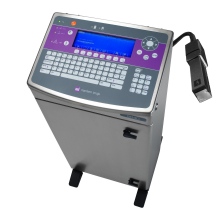 To help manufacturers address this issue, in mid-2009 the company launched its new 9000 Series line of versatile, heavy-duty inkjet coding printers for primary package coding—comprising printer models 9020, 9030, 9040 and —to meet the product ID needs of a boad range of food, beverage, pharmaceutical and cosmetics industries, offering a choice of single-jet and bi-jet printhead configurations, a large selection of inks for printing possible on just about any type of substrate, and operator friendly, intuitive user interface for easy system monitoring and control.
To help manufacturers address this issue, in mid-2009 the company launched its new 9000 Series line of versatile, heavy-duty inkjet coding printers for primary package coding—comprising printer models 9020, 9030, 9040 and —to meet the product ID needs of a boad range of food, beverage, pharmaceutical and cosmetics industries, offering a choice of single-jet and bi-jet printhead configurations, a large selection of inks for printing possible on just about any type of substrate, and operator friendly, intuitive user interface for easy system monitoring and control.
According to Markem-Imaje, “The ability to closely monitor the codes being printed on each product at all levels within the packaging line process is critical to most industries.
“Wrong, missing or illegible codes could lead to fines, product recalls and, potentially, products not being accepted by the retailer or customer. All of these consequences could affect your brand perception for identity and quality.
“Wrong or illegible codes impinge on the brand in many ways, including additional labor costs, product and packaging materials, disposal of the used materials and packaging line downtime time to lost to reworking the product—as opposed to recoding, marking and verifying the mark on the product correctly the first time.”
• Microanalytics, a subsidiary of MOCON, Inc. (Booth #6232).
Founded in 1992, the Round Rock, Tex.-based Microanalytics specializes in practical sensory analysis technologies that help food manufacturers identify and neutralize sources of industrial odors, which has emerged as a major nuisance issue for the food industry following consumer complaints about moldy or musty odors associated with nausea, stomach pain, vomiting and diarrhea.
“For example, imported wood pallets have come under fire for allegedly imparting odors to the products being stacked and distributed on them,” explains Microanalytics operations manager Fred Kuhrt. “There are fingers being pointed towards a chemical called tribromophenol (TBP), which is still used as a wood preservative in certain countries to control fungi and pests, and its byproduct 2,4,6-tribromoanisole (TBA), as being responsible for the odor.”
Bad Smell
Although TBP has been banned in the U.S., Canada and Europe, it is still used in South America, notes Kuhrt, and in times of domestic wood supply shortages TBP-treated pallets can end up in the distribution channel—with significant downstream impact on absorption of odors into food and pharmaceutical products.
“Because contamination can be instantaneous and quickly spread to other pallets, truckloads and even physical plants, it is key to identify the problem as quickly as possible to minimize financial impact and damage to brand equity,” Kuhrt says.
“Warehouses should be particularly sensitive to any odd odors emanating from pallet loads.”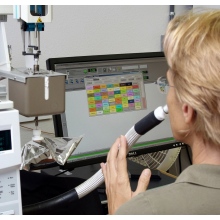
According to Kuhrt, the health risk to mammals presented to exposure by TBP has been studied and given a Hazardous Materials Identification System (HMIS) rating of two on a zero-to-four scale, defined as: “A temporary or minor injury may occur.”
Says Kuhrt: “In comparison to TBP, the HIMS rating for TBA in the area of health is zero, with no testing having been done, to my knowledge, to indicate that TBA at these low levels would be harmful to mammals.
“Keep in mind that the human nose, on average, will detect the presence of TBA at the sub-parts-per-trillion concentration,” Kuhrt cautions. “However, all off-odors that are of a concern to the public should be investigated to determine if there are health issues associated with them.
“In many cases, because of the low threshold of most off-odors, the nose will pick up the odors well in advance of the concentration being high enough to be classified as a health hazard.”
The company’s innovative, proprietary AromaTrax GCMS-Olfactometry system combines state-of-the-art technology with the human sense of smell to identify specific chemical odorants—down to parts per trillion or quadrillion, according to Kuhrt.
In a nutshell, the system is designed to work by separating each chemical compound and delivering it to a designated odor ‘sniff port,’ after which a human analyst, or ‘the nose,’ evaluates and grades each compound by intensity and odor characteristic to characterize the critical odors.
“This is relatively complex technology,” says Kuhrt. “In addition to the technology that has gone into the instrumentation, we also have developed ‘bookkeeping’ software that allows the analyst to react quickly to the compound presented by giving them a way to log their findings immediately.
“Speed is critical, since analysts often have only a second or two to respond to one compound before the next one presents itself via the sniff port.”
Although the AromaTrax system is capable of identifying thousands of compounds, typically only a small number are responsible for most odor problems, Kuhrt explains, adding that the technology’s wide-reaching applications make it suitable for researching odor issues in any solid, liquid or air sample—and even the walls of the plant itself.
Adds Kuhrt: “The work we do ranges from environmental concerns to consumer product investigation, to identifying possible sites in a process where a contamination might have occurred, with all the testing designed to meet the customers’ specific needs.
“We also manufacture and sell the AromaTrax instrument to those companies that have more than an occasional need to identify odors and have the trained staffing to do the job, as well as provide all the training as needed.”
• Multivac Inc. (Booth #6242)
“From our perspective as a manufacturer of food packaging equipment, the food safety focus is on making the machine conducive to complete and thorough sanitation by the customer, the food processor,” says Jerry Hirsch, Multivac’s manager of marketing communications in Kansas City, Mo.
“This includes making it resistant to accumulation of solid and liquid contaminants,” citing the commonly-referenced Ten Principles of Sanitary Design framework developed by the American Meat Institute’s (AMI). “This is one of the foundations upon which we base our hygienic design.”
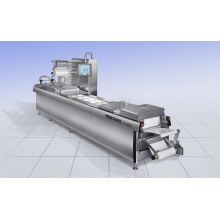 The company’s versatile, high-capacity model R 535 thermoform packaging machine provides a good example of food processing and packaging equipment being designed for optimal sanitary operation, according to Hirsch.
The company’s versatile, high-capacity model R 535 thermoform packaging machine provides a good example of food processing and packaging equipment being designed for optimal sanitary operation, according to Hirsch.
“The whole interior of the machine has been optimized for easy cleaning and maintenance tasks, as well as for CIP (cleaning-in-place) maintenance,” he explains. “The sides of the machine open easily to access the interior parts, such as the chain guide, chain and motor.
“The machine’s stainless-steel construction is completely washdown-compliant and, in accordance with the AMI sanitary design standards, the machine’s exterior has no corners or edges, so that any washdown water and any contaminants flow away easily.”
Offering cutoff lengths up to 1,300-mm, throughput rates of up to 30 cycles per minute, a control system with 30 languages, and a broad range of custom-built options, the R 535 theromformer can be integrated in PC- or server-based systems, Hirsch adds.
• Mettler-Toledo Hi-Speed (Booth # 302), part of the Mettler-Toledo Product Inspection Group, along with Mettler-Toledo Safeline and Mettler-Toledo CI-Vision, supplies high-performance checkweighers, metal detection, X-ray inspection and machine vision inspection systems and technologies to a broad range of food, beverage, pharmaceutical, and chemical industries.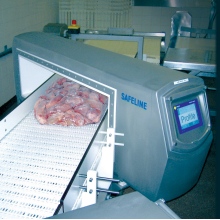
Weight Gain
According to Mettler-Toledo Hi-Speed product manager John Uber, checkweighers are playing an increasingly important role in protecting the food and pharmaceutical supply chains—being used right across the primary processing, primary packaging, secondary packaging and bundled-loads inspection and detection applications.
“Although underweight packages may create an unfavorable image for any company, when you’re dealing with pharmaceuticals, any underfill poses a health hazard, since correct dosages are often critical to life itself,” Uber explains. “On the other hand, overfills can present problems in many processes downstream.
“For example, retort may not heat to the required temperature to protect the security of the product.”
For Mettler-Toledo Safeline product manager Robert Rogers, metal detectors and X-ray systems offer an effective means of protecting the consumer and further processing equipment from damage by ensuring the product is free of physical contaminants—often acting as critical control points (CPP) within a production line process—by inspecting incoming ingredients or materials in various stages of processing and production, including final packaging.
Because the main goal is to prevent contamination rather than merely detect it, says Rogers, “It is not enough to simply have the systems in place; they must be incorporated into an overall contamination prevention program that includes areas for frequency of testing, handling of rejected product, and tools to identify contamination at the source, so that processes can be modified to eliminate it completely.”
While a metal detector works by reacting to conductivity in a product, X-ray inspection examines its density, explains Rogers.
“Either inspection system can be used on a pumped liquid or slurry products from processing to packaging,” adds Rogers. “If a problem is detected in the product, a valve in the pipeline is opened to discharge it, or the line is stopped.”
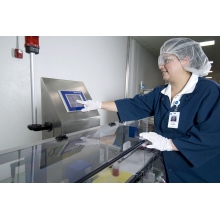 For their part, machine vision systems can also be used throughout the production process, according to Mettler-Toledo CI-Vision marketing manager Scott Stone, and are playing an increasingly vital role in brand protection.
For their part, machine vision systems can also be used throughout the production process, according to Mettler-Toledo CI-Vision marketing manager Scott Stone, and are playing an increasingly vital role in brand protection.
“Given the importance of the brand, damaged or malformed packaging, skewed labels or, in the worst-scenario, incorrect labels can severely impact the company image or trigger a costly recall,” Stone states.
“Our label vision inspection systems use multiple cameras to accurately detect any of these issues at high line speeds, and they can also be used to inspect empty or filled bottles of any shape,” he explains.
“With our proprietary [CIVCore] software, enduser food and drug companies can also perform multiple inspection operations simultaneously—such as ensuring proper neck shape, detecting the presence of foreign material in the bottle, ensuring proper fill level, detecting misapplied caps, and verifying the presence, positioning and correctness of the label.”
Advertisement

